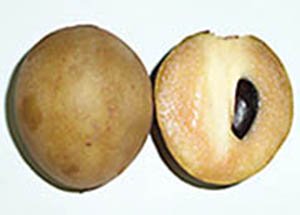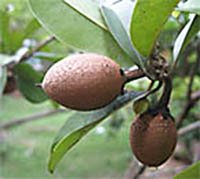Sapodilla (Sapota) Nutrition facts
Sapodilla or sapota (chikoo) is another popular tropical fruit in line with mango, banana, jackfruit, etc. Sapota is composed of soft, easily digestible pulp made of simple sugars like fructose and sucrose.
Sapota is a tropical evergreen, fruit-bearing tree belonging to the family of Sapotaceae, in the genus: Manilkara. The fruit, popular as nasebrry, is one of the most relished tropical delicacies in the Caribbean islands. Scientific name: Manilkara zapota.
 |
| Sapota fruit cut section. Note dark brown seed. |
Sapote is thought to have originated in the Central American rain forests, probably in Mexico and Belize. Today, its cultivation has spread across the tropical belt from its native habitat and has successfully grown as far as India, Sri Lanka, Indonesia, and Malaysia as a major commercial crop.
The tree is fast-growing, wind, and flourishes well even under dry arid regions receiving scanty rains. However, irrigation during summer will yield good produce.
Botanically, sapodilla fruit round or oval-shaped berry, measures about 10 cm in diameter, and weighs about 150 g. A tree can produce as many as 2,000 fruits/year.
 |
| Sapota fruits. Note rusty-gray, raw fruits. (Photo courtesy by Narith5) |
Sapota fruit has a gray/brown, sandy, kiwi fruit-like outer surface but without the fuzziness. Unripe fruits possess white, hard, inedible pulp that secretes the sticky latex-containing toxic substance saponin. This milky latex gradually disappears, and its white flesh turns brown as the fruit matures. Once ripened, it becomes soft, acquires a sweet taste, and has smooth or grainy textured flesh with a slight musky flavor. It contains about 3-10 black, smooth, shiny biconvex/bean-shaped, inedible seeds, located at its center.
Health benefits of Sapodilla
Sapodilla is one of the high-calorie fruits like bananas. 100 g provides 83 calories (almost the same as that of sweet potato).
The fruit is rich in antioxidant polyphenolic compound tannin. Tannins are a composite family of naturally occurring polyphenols.
Studies suggest that the tannins possess astringent properties and shown to have anti-inflammatory, antiviral, antibacterial, and anti-parasitic effects. Hence, these compounds may find useful applications in traditional medicines such as antidiarrheal, hemostatic (stops bleeding), and as a remedy for hemorrhoids.
Also, the anti-inflammatory effect of tannins may be found useful in conditions like erosive gastritis, reflux esophagitis, enteritis, and irritating bowel disorders. Some other fruits that also rich in tannins include pomegranate, persimmon, and grapes.
Sapote contains a good amount of antioxidant vitamins like vitamin-C (24.5% of recommended daily intake per 100 g of fruit), and vitamin A. Vitamin-A is essential for vision. It is also required for maintaining healthy mucosa and skin. Consumption of natural fruits rich in vitamin A is known to offer protection against lung and oral cavity cancers.
Further, the consumption of fruits that are naturally rich in vitamin C helps to boost immunity and scavenge harmful free radicals from the human body.
Fresh ripe sapodilla is a good source of minerals like potassium, copper, iron, and vitamins like folate, niacin, and pantothenic acid. These compounds are essential for optimal health as they take part in various metabolic processes in the body as cofactors for enzymes.
| Principle | Nutrient Value | Percent of RDA |
|---|---|---|
| Energy | 83 Kcal | 4% |
| Carbohydrates | 19.9 g | 15% |
| Protein | 0.44 g | <1% |
| Total Fat | 1.10 g | 3.5% |
| Cholesterol | 0 mg | 0% |
| Dietary Fiber | 5.3 g | 14% |
| Vitamins | ||
| Folates | 14 µg | 3.5% |
| Niacin | 0.200 mg | 1% |
| Pantothenic acid | 0.252 mg | 5% |
| Pyridoxine | 0.037 mg | 3% |
| Riboflavin | 0.020 mg | 1.5% |
| Thiamin | 0.058 mg | 5% |
| Vitamin A | 60 IU | 2% |
| Vitamin C | 14.7 mg | 24.5% |
| Electrolytes | ||
| Sodium | 12 mg | 1% |
| Potassium | 193 mg | 4% |
| Minerals | ||
| Calcium | 21 mg | 2% |
| Copper | 0.086 mg | 9% |
| Iron | 0.80 mg | 10% |
| Magnesium | 12 mg | 3% |
| Phosphorous | 12 mg | 2% |
| Selenium |
0.6 µg | 1% |
| Zinc | 0.10 mg | 1% |
There exists many cultivars of sapodilla are grown worldwide like:-
Brown Sugar variety -Fruit is medium to small, 2 to 2-1/2 inches long, nearly round. Skin is light, scruffy brown. Flesh pale brown, fragrant, juicy, very sweet and creamy, texture slightly granular. Quality is superb.
Prolific variety - the fruit is round-conical, 2-1/2 to 3-1/2 inches long and broad. Skin is scruffy, and brown, becoming nearly smooth at maturity. The flesh is light-pinkish, mildly fragrant, texture smooth, flavor sweet, and quality good. The tree bears early, consistently, and heavily.
Russel type- The fruit is large, round, 3 to 5 inches in diameter and length. Skin is scruffy brown with gray patches. The flesh is pinkish, mildly fragrant, texture somewhat granular. The flavor is rich and sweet.
Tikal- A new seedling selection with excellent flavor. It is elliptic, light brown, and smaller than the Prolific variety. Ripe very early.
Selection and storage
Sapodillas can be available all around the season in the markets. Harvesting is usually done by plucking each fruit gently as you do in mangoes. It is often difficult to tell when sapodilla is ready to harvest. Mature fruit appears brown and easily separates from the stem without the leakage of latex. Scratch on the surface to make sure the skin is not green beneath the scurf.
In the stores, buy fresh sapodilla with smooth, intact skin and without cuts/cracks, bruises, or wrinkles. Once ripened, the fruit just yields to gentle thumb pressure.
Mature but unripe fruits must be kept at room temperature for 7 to 10 days to ripen. The firm, ripe sapodillas can keep well for several days in the home refrigerator and if set at 35° F, they can be kept for up to six weeks.
Preparation and serving method
Wash the sandy scruff before eating in cold water. Fresh sapodilla should be eaten when it turns soft. Cut the fruit into two halves, then scoop the flesh using a spoon and discard the seeds. It should be enjoyed without any additions in order to experience its unique flavor.
Here are some serving tips:
Fresh sapota sections are a great addition to fruit salads.
Sapodilla-milkshake (chikoo milkshake)/smoothie is a favorite drink in Asia.
It is also used in ice creams, fruit-jam, cakes, pies, etc.
Safety profile
Latex and tannins are highly concentrated in raw sapodilla fruits and, therefore, intensely bitter in taste. Eating unripe fruits may cause mouth ulcers, an itchy sensation in the throat, and breathing difficulty, especially in children. (Medical disclaimer).
≺≺ Read Mamey Sapote nutition facts
≺≺ Back to Fruits from Sapodilla (Sapote). Visit here for an impressive list of all varieties of fruits with complete illustrations of their nutrition facts and health benefits.
≺≺ Back to Home page.
Further Resources: